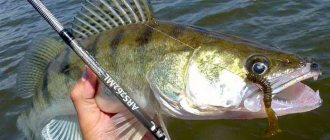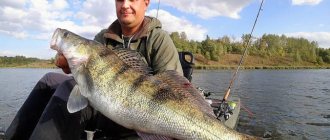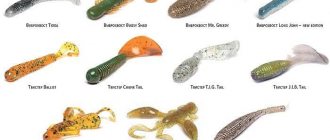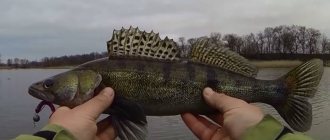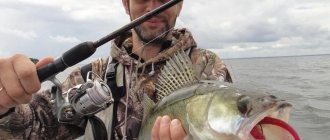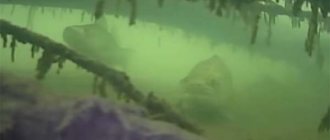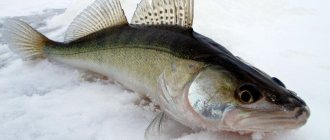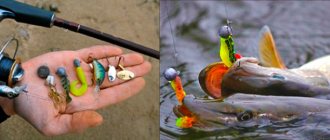Autumn fishing on the Moscow-Volga canal
Alexey Khludov Focusing on the Moscow-Volga canal, we will also consider individual sections of the water areas adjacent to the reservoir canals that are attractive from the point of view of the milker. Depending on the characteristics of the place in the fall, it is possible to use various bottom gear.
The Moscow-Volga Canal and the adjacent reservoirs are famous not only for the beauty of the surrounding nature, but also for the species diversity of fish. However, bottom fishing here is not so simple. The fact is that schools of large fish constantly move across a very elongated water area, in which the current changes all the time, and it is possible to
sit in some place for several days without catching anything, but if, say, a school of bream approaches, then the bite and catch will be guaranteed.
The extent to which the Moscow-Volga Canal is a large-scale and complex water system can be judged by the fact that it has 240 hydraulic structures. The length of the canal is 128 km, the width along the water surface is 85 m, along the bottom 45 m, the depth is 5.5 m. But we will dwell only on individual sections.
All this created favorable conditions for the development of bottom mollusks, in particular zebra mussels, which constitute the main food of most adult cyprinid fish, including bream, ide, roach, silver bream, etc. that live in the canal. Due to the sufficient amount of food, the fish in the canal and in the adjacent areas of reservoirs it is quite well-fed.
Considering that the canal is regulated along its entire length, fish, naturally, can migrate exclusively within the water area limited by the locks, but these areas are very extensive, in some places they even include reservoirs, and not one, but several. However, most of the fish are concentrated in short sections of the channel between reservoirs or their bays. Thus, the section of the canal from the Pestovsky to Pyalovsky reservoir in the area of the village is very attractive for bottom fishing for various fish. Vitenevo. The area between the Pestovsky and Ikshinsky reservoirs is also famous for good catches of bream, white bream and silver bream. And with live bait donks in both areas it was possible to tempt large pike perch.
Fishing in short sections of the canal between reservoirs is not easy because the fish here are very wary. Despite this, a lot of it perishes under the propellers of ships, because if a barge is heavily loaded, then it gives a draft of up to 4 m, and then some 1.5 m remains between the bottom of the ship and the bottom of the canal. Due to the fact that along the canal Vessels sail frequently, and the fish are forced to settle in the fairway depths between feedings, or even completely leave the channel to larger and calmer water areas. But a large amount of food at the bottom of the canal attracts her here again like a magnet.
Schools of bream, bream and silver bream in the canal concentrate in certain areas, and for effective fishing it is important to identify these places. When searching for points suitable for fishing, you can rely on experienced bottom fishers, who usually rely on night fishing, since at night the movement of vessels on the canal decreases, and the fish, having calmed down, begin to actively feed at points known to it. Let's say, if we take the section of the canal closest to Moscow, then usually experienced bream fishermen can always be seen gathered in the evening at their favorite places in the Left Bank region - at the exit from the Khimki reservoir. In the daytime, here the fish move to the depths of Dolgiy Bay, located immediately beyond the cape from the canal, or to the depths of Butakovsky Bay. At night, schools of white bream and bream often approach the area of the Moscow Ring Road bridge.
At the same time, both in daylight and in darkness, you can catch trophy fish in Dolgiy Bay itself. Moreover, experienced fishermen have been successfully catching large carp here for several years in a row. An acquaintance caught 14 kg of carp this summer.
In Dolgy, promising depths for fishing range from 2 to 5 m. There is a lot of algae at the bottom, but there are also many unovergrown areas. Carp and bream sometimes come to feed at depths of 2.5–4 m in the algae area. If during the winter, when fishing with a jig from the ice, an angler managed to study the bottom well and found special places free of algae, then by casting bottom tackle on them in the summer, he will have a great chance of catching a trophy fish. In Dolgy, small roach, crucian carp weighing up to 1.5 kg, and bream up to 3 kg are regularly caught. An angler who has better studied the bottom of the named bay can find promising areas for fishing within the ditch, which runs along the bottom of the bay along the wooded shore. With the passage of heavy ships, the current in the bay, as well as in the canal itself, begins to be noticeably felt, and the equipment is dragged. It clings to bottom algae, so you should periodically remove it and inspect it, otherwise you won’t get a bite. For bottom fishing in the bays and reaches of reservoirs adjacent to the canal, feeder gear is most suitable. It is better to take a rod 3.2–3.6 m long with 60–120 g of dough, which will allow you to cast the feeder far and, if you catch a large fish, will make it possible to successfully fish it out. The equipment is selected according to the fish. If you are purposefully determined to catch large carp, then it is better to use braided fishing line in the feeder equipment, both main (0.2–0.25 mm) and leader (0.16–0.18 mm). It is better to use short leashes for fishing in places where there is no strong current - 10–15 cm; one below the feeder, the other above. To catch bream and trophy crucian carp, it is better to take monofilament leashes made of fishing line with a diameter of 0.25–0.30 mm. The feeder is flat-oval, sliding, with a row of wire arms on one side, under which the feed mixture is driven. As its basis, many people take steamed pearl barley with the addition of cake. This is enough for catching carp, large crucian carp and bream.
Catching pike perch with a jig on the Moscow Canal
Catching pike perch with a jig. Almost seven decades ago, a canal was built connecting two rivers - the Volga and the Moscow River. The main goal of the construction was to create a transport route from the great Russian river to the capital. But we, in fact, are interested in fishing on this “north Moscow region” water artery. And we will talk about catching pike perch with a spinning rod on a jig...
A bit of hydrology
The length of the canal is 128 km, on which 7 reservoirs and 8 locks are located. The average width of the canal is 100-120 m, but there are narrowings and spills. The average depth is 5-7 m. On the “pipes” - straight sections of the canal - there is a dump along both banks at a distance of 10-15 m from the shore. Therefore, in cross section the channel has a “trough-shaped” shape.
The dump is followed by a more or less flat bottom. However, there are many areas where the terrain differs from the “standard”. This could be a steep clayey edge running at a distance from the shore, or a double edge, or shell rock. Such places are more attractive for fish and, first of all, for our main character - pike perch. We will talk about fishing from the shore.
How does pike perch behave on the canal?
To successfully catch fish of a certain species, you need to know its habits, migration processes and feeding habits, and also take into account the characteristics of the reservoir in which you intend to fish. A canal is an artificial reservoir. Constant shipping and locking make fishing very difficult.
But if we take into account all the conditions in which it occurs, then the chances of catching a “fanged one” will increase many times over. So, the bottom topography of the canal is such that pike perch have no choice but to constantly move in search of prey. That's why he's a passer-by here. And if yesterday you fished well in some section of the canal, then you can’t say with confidence.
That pike perch will be caught here today as well as the day before - it may simply not be there. I've found myself in similar situations many times. Friends reported a simply “killer” bite yesterday, and when I arrived the next day, I was left with nothing many times. This is the main feature of the bite on the channel - its unpredictability. Although, of course, there are many places (usually near reservoirs or waterworks).
Where pike perch appears much more often, and the bite can be systematized. But it’s impossible to say with 100% certainty whether there will be a crazy bite today or whether we won’t see a single bite. It has been noticed that pike perch behave approximately the same throughout the entire channel. If it happened to be good to fish on a specific day, say, in Iksha. Then rest assured.
In Rozhdestveno or Solnechnaya Polyana, the bite will be no better and no worse. But there may be different time intervals. Pike perch on the channel is very often (if not always) caught “by the hour.” For example, in summer it bites better at dawn and at night, and in the cold season - throughout the day. But there is still a certain period of time (an hour and a half). When there are significantly more bites than before or after.
Perhaps the most significant argument in favor of the bite or lack thereof on the channel is the current. Indeed, with a strong current, pike perch are caught better. Moreover, bites occur close to the shore, right behind the dump. In the absence of a current, there is either no bite, or it is weak, and the pike perch moves further from the shore. This is explained simply.
The current forces the fish to move and actively feed, coming closer to the shore for prey, while the absence of current affects the pike perch exactly the opposite. For example, near Iksha on the canal there is a point where a clayey edge with shell rock extends at an angle from the shore. When the current is strong, pike perch is caught exclusively under the bank ridge.
Where the dump comes close to the shore. When the current is weak or when there is none at all, the bites move to the place where the edge is as far away from the shore as possible. Approximately the same can be seen on the “Pipe” in the Rozhdestveno area, and in general where the canal connects with the reservoir. The intensity of the current depends on the day of the week.
So, on Tuesdays, preventative work is carried out on the locks - the current is “turned off”. It is only present in the morning and evening, and is not very strong. I did not observe any significant improvements in the bite after “turning on” the current. Therefore, it is better to come here on other days. I tried to identify the dependence of the pike perch bite on the canal on weather conditions.
And I must say, nothing good came of it. The pike perch could peck madly even when the pressure changed sharply, or it could ignore the offered bait when the pressure was stable. So for some time now, when going fishing, I listen to the weather forecast just to be properly equipped.
Effect of water temperature on pike perch bite
On the canal, this is manifested in the fact that in the cold season, pike perch are mostly schooling and are caught in “outs”, but in the summer and early autumn, single fish are found, standing, as a rule, under a nearby dump even in the absence of a current. In summer, the schooling of pike perch is less pronounced. All my “knocked out” summer flocks were tied to the relief (edge, shell rock).
Whereas in early spring, for example, a flock can be found on a completely flat bottom, without any irregularities or obstacles. This indicates the active movement of schools of pike perch at this time of year. You often hear about this. That pike perch (and any fish in general) enters the canal from neighboring rivers only in the summer, after spawning. And leaves from there when it gets cold.
Therefore, in spring and autumn there is nothing to do on it. This idea is fundamentally wrong. Fish, in particular bleak, enter the canal in the spring. It is significant that many lovers of float fishing call this period the most successful for catching bleak. Probably, the pike perch also enters the channel following the laundry. But the quantity is clearly inferior to the latter.
It was not possible to identify any strict dependence of the migration of pike perch on the entry of bleak. Perhaps there is no clear answer to this question yet. Now let's look at the entire fishing season on the canal - from early spring to late autumn. Around the end of the third ten days of January, the channel becomes free of ice. The flow is “turned on” - a test pumping of water occurs.
It mostly erodes the riverbed, creating decent and, more importantly, unreliable edges along the banks. Of course, you can fish during this period. A pike perch comes across. But the bite is, to put it mildly, mediocre. After all, spring is still quite far away. And everyone knows that even in non-freezing reservoirs, pike perch at this time is caught from time to time.
The main bite in spring occurs during the period when the canal is completely free of ice. It’s difficult to talk about exact dates here, since this could happen either in February or early April. In any case, you need to monitor the current situation and be prepared. It is important not to miss the moment of the autopsy and the subsequent week and a half. It is during this period that the most impressive catches occur.
Ice erosion occurs from north to south. First, the canal opens in the area of Dubna, then gradually this process shifts towards the capital. Moreover, if there is still ice in the southern part of the canal, then it may very well be that somewhere under the same Dubnoy canal has been open for a week. The erosion rate, depending on weather conditions, ranges from 0.5-5 km per day.
Sometimes a “pipe” several kilometers long is washed away in a couple of days, and it may be that a small section, especially at turns and expansions, will finally be free of ice a week after the first gullies appear. Reservoirs are the last to be cleared of ice.
Tactics and techniques for catching pike perch
The tactics for catching pike perch at this time are not difficult. There are two options. You can fish all day at one point. But you risk not seeing a single bite. In this case, you need a positive fishing experience (yours or someone you know) in this place. The pike perch is now very active. Therefore, sooner or later he will encounter your bait. Moreover, there should not necessarily be any anomalies in the relief.
Sometimes the pike perch point is on a completely flat bottom. In general, there is nothing complicated in such tactics. But personally, I prefer another option - an active search for a school of zander. In this case, the bet is placed on the kilometers traveled. It is irrational to make more than 4-5 casts on the spot. The pike perch, if there is one, will respond in the second or third time at most. You can learn about deepening devices for trolling here.
The most popular bait in early spring is, of course, a jig, as well as dragging rigs such as a “paternoster” or something similar. After 1.5-2 weeks of biting, immediately after opening the channel, the pike perch begins to take much worse. Mainly due to the weakened current. Of course, he gets caught, but the bite is indirect.
And improvement will come only after the next water discharge. When it will happen is difficult to predict. This comes as a surprise to some extent. But in any case, the bite will be somewhat worse than in the first days immediately after opening the reservoir. When the water rises to the “summer” level (usually in mid-April), the pike perch begins its pre-spawning feast.
Now it gathers in large flocks that move around the water area of the reservoir. Moreover, the flock can be located both near the shore and at a distance from it. The strength of the current during this period has little effect - the pike perch is forced to actively move in search of prey by the feeling of hunger. Very often at this time it is possible to find a school of bream, which is “grazed” by pike perch.
The flock itself is determined by the pokes on the reel and mucus on the fishing line and bait. In approximately two cases out of five, if you throw it just a little to the side, you will encounter pike perch, sometimes very large specimens, from 1.5 kg and above. The school of pike perch stands a little further from the bream. But it moves strictly in the same direction.
However, this period neatly fits into the “two-month” ban on spinning fishing, which is meaningless in its essence. But immediately after the ban ends, pike perch can be caught well throughout the day, regardless of the weather. And this continues until the end of June - beginning of July. It all depends on the heating of the water, but there is no strict dependence observed here.
Usually it’s been a week since it’s been warm and the water has warmed up, and the pike perch is still biting well. Then suddenly, sometimes the very next day, the bite suddenly disappears. And pike perch begins to be caught exclusively at dusk and at night. In summer, pike perch prefers to stay in shallow water and closer to places with difficult terrain. He usually stands on the edge.
Wobblers
And if the current is strong, it is caught from the coastal dump. And in its absence, pike perch can be found on the far edges, running at a distance of 30-50 m from the shore (they are usually indicated by buoys). In the summer, in addition to jig baits, you can successfully use wobblers (especially when fishing at night in shallows), as well as various spinners.
You can use wobblers yourself - in this case, choose shallow diving models and drive the wobbler, if possible, along the coastline or at a slight angle to it. The most promising time for fishing with wobblers is twilight and darkness. It is also possible to use wobblers in combination with bottom equipment such as paternoster, etc.
Jig bait
But jig, without a doubt, is much more promising. Most often I use “foam rubber”, and in a strictly non-stick design. And that's why. It is not difficult to imagine how much all kinds of garbage is hidden from our view in the water area of the canal. Piles, cables, scrap metal, etc. are trying to “eat” our baits.
A non-hooked bait can usually be pulled through this junk where walleyes like to stand, but baits with open hooks hook with incredible ease. In addition, in the summer, when the coastal grass grows, pike perch very often stands on the very border of the algae on the side of the dump. Sometimes even in the grass itself. Therefore, the hook tips of the “foam rubber” must be pressed tightly.
Various lures on a jig head
The “rubber” on the jig head collects a green garland, even if you attach the bait as a non-hook type. I had a case when on a “foam rubber”, where the tips were only 1 mm apart, both hook tips became dull on the stones. I didn’t notice this in time, so the three subsequent bites turned out to be unpunished for the pike perch.
Twister and foam rubber on the jig head
If you know the bottom well in a section of the water area when there is no clutter, you can place bait with open hooks. Lurex and “rain” baits perform well - they fly as far as possible. The size of the “foam rubber” ranges from 5-7 cm. When you need an ultra-long cast, and this is not uncommon on the canal, I use a 4-centimeter mini “foam rubber”.
And when the point where the pike perch takes is near the shore, I increase the size of the bait to 10-12 cm. This “fights off” all sorts of little things. The sizes of hooks for the smallest “foam rubber” are No. 1, for medium and large ones – No. 1/0-2/0. Using smaller hooks leads to more slips. I can advise you not to use hooks designed for catching perch.
With a hook No. 3/0, a half-kilogram pike perch can be cut easily and simply. And larger ones will have less chance of getting away with impunity. A large and sharp hook has clear advantages. In places I know where there are no hooks, I use baits equipped with Owner and Gamakatsu hooks. But I make sure to make them “unhooked.”
There are fewer empty hookups, and runaways happen much less frequently. In order not to be left without bait at the end of the fishing trip, you should immediately quickly reel out the fishing line after the bait has passed the coastal dump and ran aground. Otherwise, annoying snags cannot be avoided. However, if the dump is somewhat further from the shore than usual.
It is better to make two to five more “steps”. Very often, when shallow, bites occur, and not only in the warm season. The mass of the sinker head ranges from: to 20 g. And depends directly on the current. The most popular weights in weak currents are 14 g, in strong currents -17 g, in strong currents and wind - 20 g.
But there are exceptions both in the direction of increasing and decreasing the sinker. For example, when fishing in the immediate vicinity of a lock, due to a strong stable current, sometimes it has to be increased to 22-23 g. And another option is when fishing takes place at the junction of the channel with the reservoir on the “arrow”.
Usually in such places an oblique dump runs away from the shore at an angle to the main channel of the canal. More often the bites are distributed along its border, but there are situations (for example, when fishing in the summer, at dusk) when the pike perch runs aground and bites well. The weight of the jig head has to be reduced to 7-9 g and instead of the usual two or three turns of the reel handle, four or five turns must be made.
The main thing is that pike perch are caught
Such conditions exist, for example, on the well-known “Pipe”, on the section where the canal connects with the Pestovsky reservoir. I had to catch pike perch there using the method described above in two cases out of five, and precisely in the summer twilight. Dragging rigs also perform well.
The main thing is not to get too carried away by the weight of the jig head and move the rig as slowly as possible, as an option - with complete stops for a second or two. Wiring for demolition is also possible. But more often it’s something in between. I usually tie a 20-25 g weight to the fishing line. I think its shape will not fundamentally affect anything, although, of course, special Walker-type sinkers are preferable.
Behind the sinker is a 50-70 cm long leash with bait. Usually this is a polyurethane foam fish 4-6 cm long. It does not lie on the bottom, so it clings less. Dragging rigs work best when the bite is mediocre, when the pike perch is reluctant to respond to a regular step-by-step retrieve. Drag rigs most often helped me out when fishing in the drainage channels of locks.
There is an opinion that ships passing by (barges, motor ships) scare away fish, including pike perch. And to the point that he won’t bite in this place for a long time now. I saw many fishermen who, “commenting” on a motor ship passing by, turned away and went to another place. The rest, if they didn’t leave, were at least not delighted with the passing line of ships.
My experience fishing for walleye on the canal is that shipping can be completely ignored. Pike perch is a bottom fish, it is at home, so something large and iron floating above its head does not frighten it. Many times I caught pike perch directly from under the ship, drawing applause from random eyewitnesses standing on the deck of the ship.
It is important not to overdo it with casting - mooring such a colossus to the shore will be very problematic... From July to the end of August, the pike perch bite on the canal is very bad. It is very difficult to predict. There is no longer such a clear dependence on the strength of the current. It happens that a lady is caught in his complete absence. The result can be obtained at dawn and at night.
But the outings of pike perch are very short-lived. At this time, the pike perch’s younger brother, the bersh, bites noticeably better. In terms of numbers in the canal, it is not very numerous, and is inferior to pike perch. However, it is listed in the “Red Book” of the Moscow region. Therefore, if you catch a pike perch without fangs, bug-eyed and with bright stripes, send it back to the water.
But the water gradually cools, and the pike perch bite resumes again. Pike perch approach the coastal zone in search of potential prey. At this time, he is more often found on the edge or immediately at a slight distance from it. A few words about the gear with which we go hunting for pike perch on the canal named after. Moscow.
Rod
It is customary to catch pike perch with “evil” rods, so we choose this one. I fished with rods of a purely parabolic action, but they were noticeably inferior in the speed of hooking to rapier-like “sticks,” and there were more derailments due to the impenetrability of the mouth. But here the subjective factor plays a significant role. Some people prefer “rapiers”, while others prefer “parabolics” or something in between.
Therefore, you shouldn’t be too focused on finding the ideal action - fish with what you have, if the rod is more or less suitable in terms of test and length. And the result is unlikely to be significantly worse. I myself fish with a St.Croix Avid AS96MF2 rod. The entire Avid series is highly sensitive. However, this particular stick, unlike its rapier-like brothers, has a medium-fast action.
And it is more versatile in terms of lures. This is important for me, since I catch not only pike perch on the canal, but also perch and asp. If you only catch pike perch, it is advisable to take something more “purely jigging”. For example, from the Avid series (but with a shorter length) or Lamiglas 10MTS. Just don't overdo it with the dough. Up to 3/4, in extreme cases up to 1 ounce is quite suitable for us.
Well, we shouldn’t forget about range. Very often the bites shift to the fairway, so a 9-10 foot rod will be just right. For fishing with drag rigs, it is advisable to have a special rod with a top weight of about 35 g and a length of 10-11 feet. As for the fishing line (“braid”), the choice is yours. I use Power Pro 8-10 lb.
Species composition of fish
The species composition of fish in the Moscow Canal is quite diverse. It contains many species of peaceful and predatory fish. However, the following trophies are more often found on fishermen’s gear:
For this reservoir, you need a fairly powerful feeder rod with a test weight of up to 80 g. With such a rod, you can comfortably cast large feeders filled with food, and not worry that they will be blown away from the feeding point.
On the canal, bream is usually caught on the far or near edge of the channel. The nearest edge is located 25–30 m from the shore. To cast to the far edge, the angler will have to cast 50–60 m. The current on the canal is weak, so it is not necessary to add soil to the bait mixture.
Depending on the fishing season and the mood of the bream, it can bite on the following bait options:
The best time for bream fishing on the canal is August and September. During these months, the capture of a trophy specimen is most likely.
Roach on the Moscow Canal are often caught on the feeder when fishing for bream. It is better to catch it purposefully with a fly rod. For fishing for roach, fly rods 5 and 9 meters long are well suited.
Small and medium roach in this reservoir are well caught using bloodworms. Larger specimens prefer to peck on boiled pearl barley and rolled oatmeal flakes.
There are a lot of bleaks on the channel, but they are extremely small and often interfere with fishing for other white fish. You can catch bleak on short fly rods using maggots as bait. Any fine-grained mixture designed for catching white fish and having a light color can serve as bait.
Pike perch is the main fishing target for most spinning anglers fishing on the Moscow Canal. This predator comes to the canal in the spring, hoping to profit from spawning bleak. Some individuals remain in the canal and occupy the most promising areas. With the autumn cooling of the water, the “fanged” one again gathers in flocks and goes to nearby reservoirs. As a rule, pike perch on the channel respond better to jig baits. The weight of the jig heads used depends on the strength of the current and can range from 5 to 25 g. The strength of the current in the channel greatly affects the bite of pike perch. Strong traction activates the predator, and it attacks the bait more greedily.
The most promising areas for fishing
Having decided on the main fishing objects, the angler must understand in which areas the fishing will take place. There are many promising places for fishing on the Moscow Canal, but certain areas are very popular among anglers.
Canal in the Dubna area
The canal in the Dubna area, stretching from Tempy to the Ivankovskoe reservoir, can generously reward the fisherman with trophies. The depth of the channel in this area is slightly greater than in nearby ones, which was the reason for the increased concentration of a variety of fish. Here you can successfully fish with both spinning rods and float and feeder tackle.
The most interesting area for fishing is located in the area of the old lock. The bottom relief in this place is characterized by a large number of small holes and hollows. The final result of fishing will depend on whether the fisherman is able to find these holes and fish them correctly. It should be noted that the channel in this place is cleared of ice somewhat earlier than in other areas, which allows the fisherman to start the summer fishing season earlier.
Dmitrov. Yakhroma
Excellent places for fishing on the canal are located in the area of the city of Dmitrov, where the reservoir has an expansion. The only thing that upsets the angler while fishing in this area is the constant mountains of garbage and many curious people who are in a hurry to show their participation and help in the fishing process. In this place of the canal it is advisable to fish from a boat, then the angler will have the opportunity to catch large ones:
Several years ago there was a catfish weighing about 20 kg in this area. Shore fishing in this area is also possible, but it is better to fish along the right bank, since the main channel passes there. The water area close to the left bank is too shallow, so you can only catch perch there. However, in the spring, large ide often appears in this water area, which can be caught with an ultralight spinning rod equipped with a small wobbler or a spinner No. 0–1. At dawn, this sandbank is visited by asp, which can be caught using heavy spoons that allow long casting. In the summer, the shallow water area becomes very overgrown, and fishing on it becomes impossible.
Frosts. Iksha
At Morozki station, the canal is connected by a channel to a large bay, where perch and pike live in large numbers. Despite the fact that this place is characterized by strong fishing pressure, fishing here is often successful. Fish constantly migrate from the canal to the bay, so its fish stocks do not dry out.
However, for the fisherman, the channel itself is of greater interest, in which there are variable currents that invariably attract different species of fish. Night fishing in the channel for pike perch is especially interesting. To catch it, small wobblers with a depth of up to 1 m are used. Unfortunately, there is no good road to the channel, so a significant part of the path will have to be walked.
Fishing spots - Morozki and Yakhroma Reservoir
Reservoirs. Detailed reports: all notes, author's notes.
Fishing spots - Morozki (Moscow Canal) Morozki station is located on the Savelovskaya railway, immediately after Iksha station. The reservoir is quite interesting for anglers at any time of the year. Convenient access, beautiful places and, sometimes, effective fishing make this place worthy of attention.
Description of the entrance to Morozki On foot: Train from Savyolovsky station in Moscow to Morozki station. On the platform, take the steps to the bridge over the Moscow Canal. Further through the channel. By bus "Moscow - Dmitrov", running from the Altufyevo metro station to the traffic police picket located on Dmitrovskoye highway behind Iksha at the turn to the bridge. The bridge is located directly next to the Morozki station. By bus "Moscow - Dubna", running from Savyolovsky station. Stop right there. By car. Along Dmitrovskoye Highway to the traffic police picket located at the turn after Iksha station, then turn right onto the bridge. After the bridge, turn right to the canal and along it along a dirt road to the fishing spot. Description of fishing places and list of fish. Fishing plans can be made on the way across the bridge. Below there is an excellent view of the canal itself and the spill. The spill is a dammed stream that overflows before entering the canal and is connected to the canal itself by a channel. In the flood, you can catch roach, bream, tench, and crucian carp using a float rod. From time to time an ide comes across. Lots of predator. These are primarily pike, perch; at dawn, pike perch are caught in the hole in front of the canal. An asp comes in to eat from the canal. The most productive places for fishing in the flood are concentrated directly next to the channel. When fishing from the shore, it is mandatory to have waders or waders. Fishing from a boat should be considered optimal. The most effective lures when fishing with a spinning rod are wobblers, spinners, and oscillating spoons. Near the channel there is a hole up to 4 meters deep. It is quite possible to use jig baits in the pit. The canal itself is no less interesting for catching predators. Directly near the channel you can often observe an asp fighting. And even if splashes are not visible, it is still worth combing the water area with artificial bait, this fish is here almost constantly. There are a lot of perch in the canal itself. Fans of catching this schooling fish with due persistence can always count on success. Pike perch is an independent object of spinning fishing. And lovers of jig fishing often prefer not to waste their time catching other fish, but to purposefully look for pike perch. Pike perch often go out at dusk directly to the channel section, where they are caught with a floating wobbler all summer nights. Using other baits is problematic due to the large number of hooks in this place. Fans of catching peaceful fish use float and bottom gear. Due to the peculiarities of sluicing in the section of the canal adjacent to the channel and in the spill near the channel, the flow often changes its direction. In the absence of bites. You can walk or drive further upstream. To do this, it is convenient to use the dirt road running along the canal. After a kilometer and a half, there is a second spill. It is also connected by a duct to a canal, but in other respects it is somewhat different from the first. If the first spill resembles a bowl in appearance, then the second one is more likely to resemble a chamomile flower. There are several bays with varying depths and snags. Unlike the first flood, where the banks are fields and areas of damp deciduous forest, here there is a pine forest and high dry banks. The channel and adjacent areas are deeper. The fish and fishing methods are similar. In the upper reaches of the second flood there are several ponds where you can successfully catch crucian carp with a float rod. Circle fishermen stock up on small crucian carp here for their gear. Fishing spots - Yakhromskoye Reservoir If you are unlucky with your catch here, or you are interested in seeing another interesting place, then the Yakhromskoye Reservoir is at your service. In order to get to its banks, you will need to walk along the bank of the canal for another one and a half kilometers. And again upstream. The Yakhroma Reservoir is located on the Yakhroma River and overflows in front of the Moscow Canal. Then the water from it passes under the canal and again carries its waters in the form of the Yakhroma River towards Dmitrov. The Yakhromskoe reservoir has sloping and swampy banks. For successful fishing you will need either a boat (which is preferable) or wading pants, the so-called waders. The reservoir is known for a decent amount of pike and perch. There are bream, roach, tench, crucian carp. The canal itself, next to the Yakhroma Reservoir, is within the coverage area of the waterworks complex located at the Turist station, but it is impossible to cross the canal in this place using the waterworks facilities due to the operation of the access system at the waterworks itself. The canal adjacent to the waterworks is, without a doubt, interesting not only for spinners, but also for fans of catching bream on a donk. All places in the Morozki station area are interesting throughout the summer. Beautiful places, wonderful forest, comparatively sparsely populated areas and the opportunity not only to relax by the water, but also to catch decent fish make this route very attractive. And it is not surprising that those fishermen who have already been here always speak with great warmth about the time they spent on these shores. And so far I have never met an angler who did not intend to visit this body of water again.
